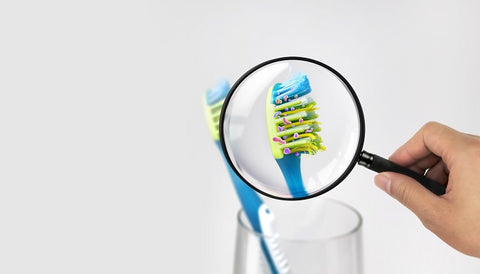A brief history of the toothbrush
Yoga, jogging, dieting, working out, no matter all the health-promoting habits out there, the most widely-practiced would always be teeth brushing. Billions of people religiously brush their teeth day after day, trying to keep their smile cleaner, whiter and healthier for longer.
People have been experimenting with various ways to clean their teeth for centuries, starting with miswak twigs around 7,000 years ago. Around 1498 in China, a bristle toothbrush (similar to the type we use today) was invented and in 1938 the first nylon bristle toothbrush went on sale. Those are just a few milestones in the long history of people recognising the importance of good oral care.
You would’ve guessed that 7,000 years of brushing have helped us figure out how to make toothbrushes both effective and safe, but a 100 years ago, a scientist by the name of CM Cobb (1), published in the Boston Medical and Surgical Journal a very novel (for its time) finding that bacteria on toothbrushes could be a dangerous source of repeated oral infections.
One hundred years later, backed by the overwhelming evidence of countless scientific studies, we know for a fact toothbrushes are heavily infested with bacteria that jeopardize not only our peace-of-mind but also our oral and general health, contributing to a multitude of health problems much more severe than bad breath or the occasional dental cavity.
How bad it actually is?
A recent study (2) published in the Journal of Dental Hygiene Science reports that “the oral cavity contains more than 700 types of bacteria and has the ideal temperature and humidity level for bacterial growth”. Using our toothbrush in such an environment “contaminates it easily with microorganisms, blood, saliva and oral tissue shed in the oral cavity”. This is one of the main ways toothbrushes become infested with bacteria, with the other due to the fact that “toothbrushes are likely to be stored in the bathroom, where they can be contaminated by aerosols created during toilet cleaning.”(4)
It becomes easy to see a huge problem brewing - while toothbrushes are supposed to be the most widely used and safest personal oral hygiene tool, it’s at the same time a perfect breeding ground for potentially pathogenic microorganism. “It takes a very short time for a perfectly clean toothbrush to get easily contaminated with microorganisms, blood, saliva, and oral tissue shed in the oral cavity.”(5)
Toothbrush Scrabble
Streptococcus mutans, Candida albicans, Staphylococcus aureus, Escherichia coli, Pseudomonas, those are not just excellent scrabble words but unfortunately also some of the most common bacteria found on regular toothbrushes as well as viruses such as herpes simplex. If a toothbrush is used for a long time without sterilisation, it serves as a reservoir for pathogenic bacteria. If a contaminated toothbrush is used repeatedly inside the oral cavity, it can cause oral and even systemic infection. No wonder a study in the International Journal of Experimental Dental Science considers the toothbrush”a potential biohazard for reintroduction of microorganisms in the oral cavity.” (3)
Good bacteria - bad bacteria
While all this information is disturbing, aren’t many bacteria species harmless and even beneficial to our health? Unfortunately, this is not the case with most of our toothbrush inhabitants. More and more scientific studies around the world investigate the connection between pathological microorganisms on the toothbrush and whether they can be the cause of actual diseases and the findings are very alarming.
Bacteria found on toothbrushes can cause dental caries, gingivitis, and stomatitis.(6) Elderly people with a weakened immune system who are exposed to S. aureus “superbug” strains can develop sepsis and enteritis. Importantly, S. aureus generates exotoxins known as enterotoxins, which cause food poisoning, resulting in symptoms of nausea, vomiting, abdominal pain, and diarrhea.(7) Such cases could be rare, but it’s very alarming that personal dental tools (our toothbrushes) which are meant to keep us safe and healthy, could be causing such worrisome issues.
It’s a numbers game
A recent survey within the UK has found that more than 40% of the population replace their toothbrush less than twice a year. Which means those people use the same toothbrush for six months or more. What happens to a toothbrush during this time?
A recent study (2) found that general bacteria were observed on 86.7% of toothbrushes used for 1 month and 100% of those used for 3 months. So, if you are not replacing your toothbrush extremely often, or have other means to sanitize it, you are basically guaranteed to be using a bacteria-infested toothbrush. This is not only gross and sad, but as seen above, potentially dangerous for your overall health.
Is there a way out
Ever since dangerous bacteria on toothbrushes has become a known problem, scientists have been testing various solutions in order to find the most effective and convenient one. From boiling and microwaving toothbrushes, to soaking them in vinegar or mouthwash, scientists are finding various degrees of success which we’ll tell you all about in a future post.
Until then, our own solution remains the sterilizing properties of the Nano-b toothbrushes. It’s our simple and effective way to fight toothbrush bacteria, backed by the power of natural elements like gold and silver. We have enough to worry about in our daily lives and the last thing we need is bacteria-infested toothbrushes jeopardizing our health.
References
- Cobb CM, Toothbrush as a source of repeated oral infections in the mouth. Boston Med J 1920;183:263-69.
- Seol-Hee Kim: Analysis of Microbial Contamination and Antibacterial Effect Associated with Toothbrushes. Journal of Dental Hygiene Science 2018;18:296-304
- Saini R, Kulkarni V. Toothbrush: AFavorable Media for Bacterial Growth. Int J Experiment DentSci 2013;2(1):27-28
- Wetzel WE, Schaumburg C, Ansari F, Kroeger T, Sziegoleit A: Microbial contamination of toothbrushes with different principles of filament anchoring. J Am Dent Assoc 136: 758- 765, 2005
- Naik R, Ahmed Mujib BR, Telagi N, Anil BS, Spoorthi BR: Contaminated toothbrushes-potential threat to oral and general health. J Family Med Prim Care 4: 444-448, 2016.
- Karibasappa GN, Nagesh L, Sujatha BK: Assessment of microbial contamination of toothbrush head: an in vitro study. Indian J Dent Res 22: 2-5, 2011.
- Lee HS, Kang KH, Kim KM et al.: Dental microbiology. Chonggumunhwasa Publishing, Seoul, pp.201-222, 2014.



Comments (0)
There are no comments for this article. Be the first one to leave a message!